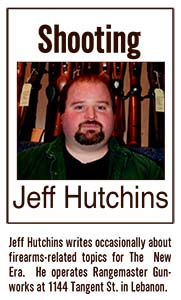Military cartridges inevitably turn into favorites of sportsmen, police and civilians.
In the U.S. this has always been the case – from the 45/70 Government, which I currently hunt elk with, to the lesser-known 30-40 Krag that took our armed forces into the modern smokeless powder era, to the 30-03 which begat the improved 30-06 that virtually every American is familiar with today.
As I stated in last month’s column, the .308 Winchester (7.62x51mm NATO in its military guise) is basically a shortened 30-06 Springfield.
This shortened aspect of the case gives it certain advantages.
For one, it can be chambered in shorter and lighter rifles, which is a boon to hunters traversing steep country. With its lighter powder charge it produces less recoil.
This is somewhat negated by the fact that it is usually housed in lighter rifles. The lighter the firearm, the less weight the recoil impulse has to move before it starts moving the shooter.
Some would say that putting a muzzle brake on the larger calibers will accomplish the same goal of reducing recoil and that is absolutely true – but with some serious trade-offs. The brake adds length to the rifle but, worse, it adds significant muzzle blast and noise.
Many shooters think they are bothered by the recoil, only to find out after the muzzle brake install that it was the noise that actually was the culprit and they have just paid a gunsmith to make it much worse.
Remington and Federal now manufacture “lighter recoil” loadings for many popular calibers, the .308 being one of them. As far as I’m concerned, this makes the venerable .308 the perfect rifle for a beginning hunter.
As we’ve already discussed the caliber is available in light, short, handy rifles that are easy for shooters of slight stature to handle efficiently. They can start off with the light recoil loads that are completely adequate on deer sized animals and later move up to the full-power ammo that can dispatch anything in North America if placed correctly.
The reloader has had this advantage available all along and since the .30 caliber is the darling of America, the bullet selection is second to none.
To this aspect, the highly powder efficient .308 loses nothing to the longer 30-06 on deer-sized animals at all. There is an advantage to the ’06 on elk and bear as the .308 is maxed out in its efficiency with 165 grain bullets as far as powder capacity goes.
The twist in the rifling of most .308s is one turn in 12 inches. This is a little too slow to properly stabilize 180-grain and heavier bullets in flight.
The 30-06 almost always has a one in 10-inch twist that can easily handle 180- and 200-grain bullets, which are better suited for elk, moose and large bear.
Another advantage to the .308 is that because of its origins in military and world-wide use, there is plenty of surplus ammunition available for practice or varmint hunting.
There is hardly a military in the world that still uses any arm chambered for 30-06 and the surplus ammo supply has mostly dried up.
As an aside, the .308 seems to work better in the sporting semi-auto rifles like the Remington 740, 742, 7400, FOUR and 750, which is strange because these rifles were specifically designed around the 30-06 Springfield cartridge.
There is one major misconception about the .308 being an excellent long range cartridge. It is not!
“But wait,” you say, “don’t the military and police use it for their counter-sniper work?”
Yes they do. The military started using it as it was already the standard in service. The police use it because the military does.
The average police sharpshooter/marksman/sniper shot is at much less than 100 yards. It is an inherently accurate round but one of the poorest “modern” cartridges for long-range use. Look at ballistics charts and you will find just about every other popular modern hunting round shoots flatter.
If I were in charge, the standard sniper rifle would be chambered in .260 Remington or possibly 6.5 Creedmoor. The result is much flatter shooting and less recoil, to boot.
The cost would also be slightly less for every round purchased. In the long ranges of today’s battlefield the .300 Winchester Magnum is much preferred and is taking over from the .338 Lapua with its new, improved loads.
If I lived in the East and only pursued whitetail deer I would use a .260 Remington, or more likely the Ackley Improved version, but as a Northwest hunter I have started all of my children off with the efficient .308 Winchester.
If they turn out to be hunters only and not necessarily “gun nuts” (like Dad), they will always be well- served by this cartridge that has so well served our men and women in uniform.
– Jeff Hutchins writes monthly about firearms-related topics for Lebanon Local. He operates Rangemaster Gunworks at 1144 Tangent St. in Lebanon.




